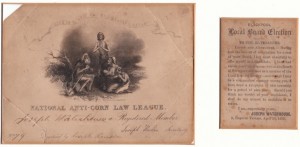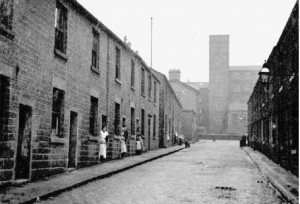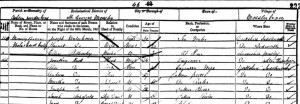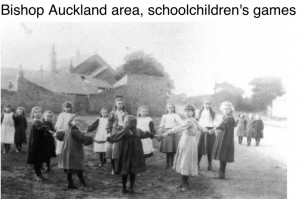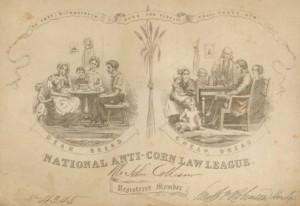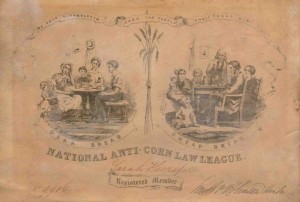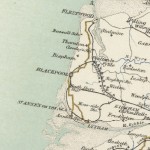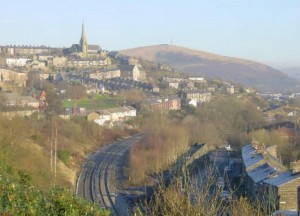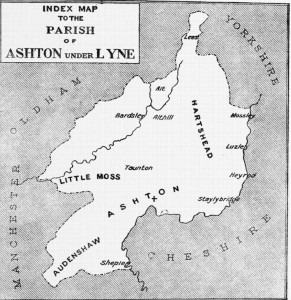Waterhouses
The Waterhouses
As recorded in the previous section, Francis William McNamara married a Waterhouse. Some years before he died Dad gave me a couple of very old, small pieces of paper for safe keeping which he said related to the ‘Anti-Corn Law Waterhouse’ who was, apparently, one of our more notable forebears. I had them framed and have kept them but I did not think much more about them at the time and foolishly never asked him for more information about this relation.
One document is a Membership Card for the National Anti-Corn Law League in the name of Joseph Waterhouse, membership number 79, see above. The Anti-Corn Law League was in effect the resumption of the Anti-Corn Law Association, which had been created in London in 1836 but did not obtain widespread popularity. The Anti-Corn Law League was founded in Manchester in 1838. Richard Cobden and John Bright were the two principal figures of the movement while George Wilson, the president of the League, was in charge of administrative duties. The aim of the League was the abolition of the Corn Laws, and this proposal was agreed by Parliament in 1846. There are many web sites which provide information about the Anti Corn Law League and the Corn Laws, see here especially and also here and here for example. And for other images of memerbership cards and pictorial information see below.
The other document looks like a small newspaper advertisement cut from a local paper, in which Joseph Waterhouse was promoting himself for the election to become a member of the Blackpool Local Board, see PDF Blackpool Local Board and for the history of Blackpool during Victorian times, see Blackpool History among various options. It is dated 1875. In his short address Joseph mentions that he has been on the Board of Surveyors and the Local Board of Mossley, see PDF Mossley Board of Surveyors and for the history of Mossley see here and here. Joseph Waterhouse was Dad’s paternal great grandfather and I have attempted to find out what I can about the Waterhouse connection.
The first record of a Waterhouse who was our forebear is Joseph Waterhouse who was born in 1796 at Ashton-under-Lyne and who died at Saddleworth in 1861. For the history of Ashton under Lyne see here. He married Sarah Parkinson who was born at Ashton-under-Lyne and who probably died in 1853 but certainly between 1849 and 1857. They were married in 1817 at Woodkirk in Yorkshire, which is now West Ardsley.
The original census record if difficult to read but the family consisted of: Joseph Waterhouse, 45 a clothier, ie someone who made or sold clothes; his wife Sarah Waterhouse, 50, no occupation recorded; and seven children Ann, 20; Joseph, 20; Esther, 15; Elizabeth, 15; James, 13; Giles, 11; and Wright, 8. Given the ages of the children it is probable that there had been other children born to the family who had died. The five eldest children, including 13 year old James were cotton weavers. Nearly all the other families living close by were employed in the cotton industry.
During the Industrial Revolution Ashton under Lyne, as with Saddleworth where the family had lived, and many Lancashire towns, developed as a major centre for the cotton industry, see here. And the booming cotton industry also lead to major improvements in the local transport systems.
One of their children was the Joseph Waterhouse to whom Dad was referring. As described above he was born in about 1821 at Saddleworth. And in 1841 was living at Ashton under Lyne with his family and working as a cotton weaver.
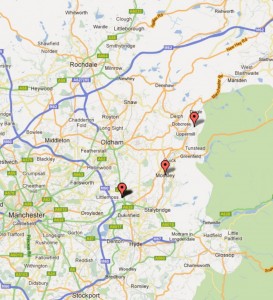
The ‘Waterhouse’ towns; Ashton is about 3 miles to the SE of Mossley and Saddleworth 4 miles to the NW
In 1846 Joseph married Harriet Rooke, who was born in 1823 at Ashton-under-Lyne and in 1851 they were living at Ashton and with them in their home was a niece, Ellen Bottomley aged three, born at Mossley. There were Bottomley families living in the area but I cannot trace Ellen Bottomly’s provenance with any degree of confidence or her links with the Waterhouses. Joseph was described as a tea dealer. Early in the marriage Harriet died, possibly at Salford during the first quarter of 1853. But Joseph did not hang about and he is recorded as marrying for a second time at Ashton and in the second quarter of the same year he married Mary who was born about 1824 at Saddleworth.
Continuing to 1861 Joseph, then aged 40, was living with Mary at 38 Vale Cottages, Saddleworth. He had become a grocer. They had two children: Mary, aged five, and Harriet, aged one, (the second wife will have liked that – naming the child after her husband’s first wife). The niece, Ellen Bottomley, now aged 13, was still living with them. She was listed as a nurse, I presume most probably to the two children. In 1863 they had a son, Joseph, and in 1865 another daughter, Alice Hannah. Then in 1880 another son was born named John Bright Lincoln. Clearly the Anti- Corn Law League had had an impact on the father.
Continuing to 1871 Joseph was recorded as living at Wood End Valley Cottages, Saddleworth, with Harriet, 11, Joseph, 8, and John Bright, one. Also Ellen Bottomley was still living with them and had progressed from nurse to housekeeper. But Mary, their mother, was not living at that address. Mary Waterhouse was listed as living at Blackpool.
She was living there with her eldest child, Mary Jane, then 15, (who later became Dad’s grandmother) and Alice Hannah, 6. The mother, Mary, was recorded as head of this household. One can only speculate about this unusual arrangement. Perhaps the family needed to maintain a second base in Blackpool because of Joseph’s attempts to become a member of the Local Board there. In his Blackpool election address of 1875 he noted that he had been a local rate payer for nine years. On a later census Mary was recorded as a lodging house keeper so perhaps the family was maintaining two businesses because Joseph was still recorded as a grocer in Saddleworth. It is unlikely that Joseph had set up house with Ellen Bottomley because she may have later married at Saddleworth in 1873. There was a regular coach service between Manchester and Blackpool and in 1846 Blackpool was connected to the main railway system. Thus travel between the two homes and businesses would not have been too difficult, Saddleworth is about 60 miles from Blackpool.
We know that Joseph made his bid to become a member of the Blackpool Board in 1875 but do not know the outcome. He died in 1880 aged 59. His death is recorded at the Fylde district, which includes Blackpool.
In 1891 Mary was living at 24, Templeton Terrace, Layton with Warbreck, which is now part of Blackpool. She was listed as a lodging house keeper and living with her were her two sons, Joseph 18, a baker’s van man, and John Bright, by then aged 11.
By 1881 Mary had retired and was living at Bishop Aukland in the home of her daughter, Mary Jane McNamara, aged 35. She was the Mary who had the misfortune to be the wife of the Francis William McNamara who emigrated to South Africa. Presumably Mary was helping to support and look after her daughter’s family. There were five children in the family including Frank McNamara, aged seven, who was to become Dad’s father.
By 1901 Mary Waterhouse had moved from Bishop Aukland back to her Lancashire roots. She was living in the home of her son-in-law, William Higginbottom, a drapery manager who was married to another of her daughters, Alice Hannah. Mary died in the Fylde region in 1906.
To return to Joseph. It is not possible to know what part the Anti-Corn Law League played in Joseph’s life. It was founded in 1838 when Joseph would have been about 17. He was not living all that far from Manchester, about seven or eight miles, where the league was first established. His membership number of 79 suggests that he must have been one of the early and enthusiastic members and he joined the League as a young man.
The examples of Anti-Corn Law League membership cards below, one is numbered 4,345 and the other 9916, demonstrate Joseph’s early commitment as a young man to what was to become a major reform movement.
And one may suppose that as an early member he may have achieved a prominent position in the organisation. The League was associated with free trade and as a tea trader and then as a grocer he had, presumably, an interest in promoting the free trade in goods and making cheap food available to all classes. The League may have encouraged him to become active in local civic affairs. Presumably the League must have still been important in his life in 1870, the year in which his youngest son who he named John Bright was born. To have risen from being a cotton weaver at the age of 20, to become a tradesman and prominent local citizen, and to have had the foresight to join a major reform movement in his teens, suggests that he was well educated and a man of some energy and determination.
An early connection between the McNamaras and the Waterhouses?
One may speculate that there was an earlier connection between the McNamaras and Waterhouses. In 1871 Francis McNamara was a lodging house keeper in Blackpool and also in the same year Mary Waterhouse was living at Blackpool and she was recorded as a lodging house keeper. It is not at all unreasonable to assume that the two families knew each other and that is how their children, Francis William McNamara and Mary Jane Waterhouse come to meet each other. Today it is not possible to locate their addresses although there is an Imperial Street in Blackpool, which is about 500 yards from the beach near the main promenade. (The current Blackpool street map suggests that all terraces have been renamed at some point.) This was a time when Blackpool was developing as a major sea-side resort. Possibly both families had acquired lodging houses to take advantage of the newly and rapidly developing holiday trade. The opening of a railway line to Blackpool did much to encourage holiday business.
A note about Mossley
Mossley is some ten miles to the east of Central Manchester. Before it became a borough in 1885, Mossley was divided between three counties: Yorkshire, Lancashire and Cheshire, and its three parts are still clearly defined by the positions of the parish churches: St. George’s (Lancashire), St. John the Baptist’s (Yorkshire) and All Saints (Cheshire).One of the main reasons for the granting of the town’s Charter of Incorporation on March 13 was to overcome the administrative problems created by the geography of the place.These remained even after the passing of the 1884 Local Government Act when Mossley was allowed its own Local Board of Commissioners. Saddleworth was included in the area.
Thus there can be problems when investigating family history in the Mossley area. For instance the same members of the Waterhouse family can be recorded as being born in Yorkshire, then Lancashire or Mossley on different records. I suspect that they were unsure how to record the information for the census forms. Just to complicate matters they may spell Mossley as ‘Moseley’ or ‘Mosley’ (which leads on to search in the Birmingham region) or even worse. Thus it can be difficult to trace family lines and places of birth and residence correctly and one needs to cross check in as many ways as possible.

